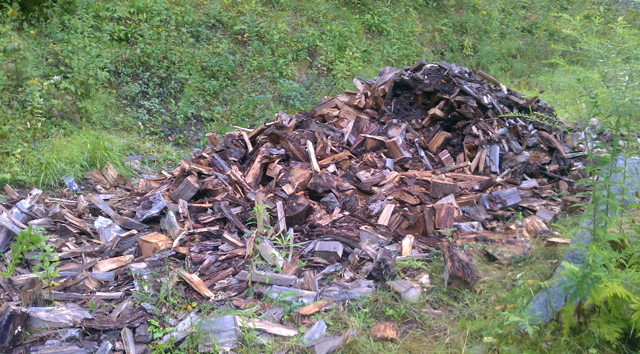I ended up not being seriously injured because I jumped clear of the pile, and only twisted my knee in the process because not a single stick of firewood hit me. That said, I learned a few things from it. First and foremost, make absolutely sure that if you are working with anything heavy, even if it is something you've done a thousand times, make absolutely sure there's someone around to hear you scream. Or in this case, the sound of the wood crashing down.
 The second is, sometimes things happen you can't predict, and the third is to replace the pallets you stack your wood on before you think they need it.
The second is, sometimes things happen you can't predict, and the third is to replace the pallets you stack your wood on before you think they need it.It may not be too easy to see on the Left, but the corner of this pallet is broken off. Just about the time I was finishing stacking the entire pile this corner piece cracked off, and the entire pile destabilized from that corner, and fell out toward me. Because I don't really have time to un stack, get more pallets, and re stack I just re stacked the parts of the pile that fell, and moved on for now.

 For those of you who haven't stacked firewood before, there is an art to it, and a science. The basic science is simple. You don't want your pile to lean. Now there is a LOT more to it than that when it comes right down to it. You need to have good airflow to make sure the wood dries out, and there are whole schools of thought on how you should stack wood to best dry. Not being an expert on the subject I won't go on about it. I ended up picking the method I did because it's the easiest one with what was already set up before we moved in. The method I chose is to just stack the wood in a vertical stack, and cover it with something.
For those of you who haven't stacked firewood before, there is an art to it, and a science. The basic science is simple. You don't want your pile to lean. Now there is a LOT more to it than that when it comes right down to it. You need to have good airflow to make sure the wood dries out, and there are whole schools of thought on how you should stack wood to best dry. Not being an expert on the subject I won't go on about it. I ended up picking the method I did because it's the easiest one with what was already set up before we moved in. The method I chose is to just stack the wood in a vertical stack, and cover it with something.Below Right you can see up close what the bottom of the straight stack style I have been using looks like in my case. Having a consistent shaped split log would make things easier. Most of our wood is split in new and interesting ways which makes it difficult to get a good even stack. The first time I stacked the pile I ended up having it topple because it was leaning out. I learned that I have to make sure things look right from multiple angles, and not just stack away.
Below Left is my attempt at demonstrating a cross stack. It is inexpert obviously, I am going to be trying to do our next stack with cross stacking if for no other reason to learn how to do it properly. It seems like it would work better with the standard square pallets which I can take home from work. I suspect if done properly it would also be more stable inherently than the straight stack.
In the long run, being able to stack wood well and efficiently is going to be important. Getting from a pile of wood to a neat orderly stack of wood needs to be something that can be done efficiently. As I get practice I suspect it will be.
For more complete information on backyard lumber jacking in general including stacking wood I'd recommend the book I picked up, The Backyard Lumberjack. It has a lot of information, and is a good read over all. As I work on bucking and splitting the pile of trees out back I'll probably do a post on that as well



Consider how the dutch stack firewood in a round silo way then toss all the odd ball pieces in the middle many you tube videos on how to do it
ReplyDelete